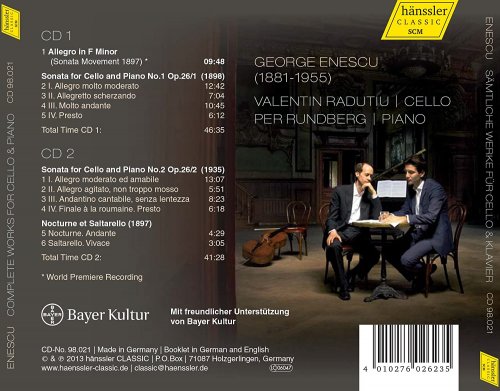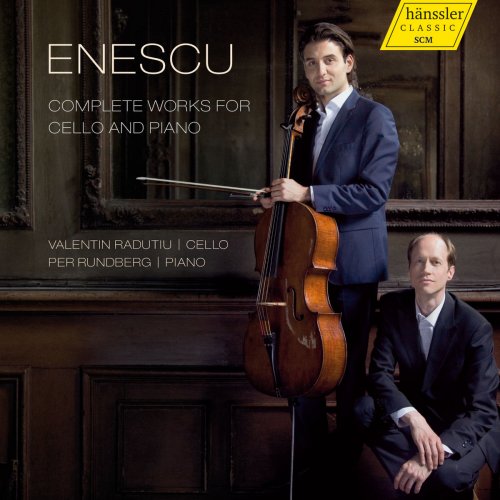
Valentin Radutiu, Per Rundberg - Enescu: Complete Works for Cello & Piano (2013)
BAND/ARTIST: Valentin Radutiu, Per Rundberg
- Title: Enescu: Complete Works for Cello & Piano
- Year Of Release: 2013
- Label: haenssler CLASSIC
- Genre: Classical
- Quality: flac lossless +Booklet
- Total Time: 01:28:05
- Total Size: 320 mb
- WebSite: Album Preview
Tracklist
01. Allegro in F Minor
02. Cello Sonata in F Minor, Op. 26, No. 1: I. Allegro molto moderato
03. Cello Sonata in F Minor, Op. 26, No. 1: II. Allegretto scherzando
04. Cello Sonata in F Minor, Op. 26, No. 1: III. Molto andante
05. Cello Sonata in F Minor, Op. 26, No. 1: IV. Finale. Presto
01. Cello Sonata in C Major, Op. 26, No. 2: I. Allegro moderato ed amabile
02. Cello Sonata in C Major, Op. 26, No. 2: II. Allegro agitato, non troppo mosso
03. Cello Sonata in C Major, Op. 26, No. 2: III. Andantino cantabile, senza lentezza
04. Cello Sonata in C Major, Op. 26, No. 2: IV. Final à la roumaine
05. Nocturne et Saltarello: I. Andante
06. Nocturne et Saltarello: II. Vivace

Rarely can two works that share the one opus number have hailed from such different musical worlds, in the case of Enescu’s two cello sonatas the comfort zone of full-bodied Romanticism and the zestful open-air environment of improvisatory-sounding folk music. There’s also a disc premiere here in the form of an undated (early) 229 bar fragment of a sonata movement in F minor marked allegro that has been completed by Hans Peter Türk. Assertive in its opening measures before turning lyrically persuasive, even passionate, Enescu sets to work on a quasi-fugal idea (5'10") that works itself into a veritable swell of lava. Schumannesque one moment, redolent of Fauré or perhaps Saint-Saëns the next, Enescu’s sonata-torso is well worth the occasional hearing. After an initial listen I had to check that the opening of the First Sonata (1898) wasn’t an unwitting repeat of the unpublished Allegro – those initial moments are so similar. Could the fragment have been a first shot at the Sonata’s first movement? The playful Allegro scherzando is crisply dispatched by Valentin Radutiu and Per Rundberg, the Molto andante, where Schumann is again a sure-fire influence, played with considerable warmth of tone.
Turn to the opening of the Second Sonata (1935), completed after a gap of almost 40 years, and we revisit the world of the celebrated Third Violin Sonata (1926), the opening minutes ruminative in the manner of folk music, the development thereafter growing more exotic by the minute, related in spirit if not in overall design to Bartók. How different too the Second Sonata’s agitated scherzo – angry, halting music spiced with double-stops, anxious pizzicatos and a challenging piano part. Next comes what is perhaps the most striking and certainly the most inspired music on the disc, the unaccompanied opening of Op 26 No 2’s slow movement, music that vies with Kodály’s Op 8 Solo Cello Sonata for eloquent purity, the latter half being particularly beautiful. Echoes of folk music dominate much of the finale, again recalling the world of the Third Violin Sonata. The second disc closes, as the first began, with youthful essays reflecting the mid-Romantics who Enescu loved (and played) so well, especially Brahms and Schumann, a Nocturne and Saltarello, very well performed.
As to comparisons, cellist Laura Buruiana and pianist Martin Tchiba (Naxos) level nearest to Radutiu and Rundberg, similar in approach, though I find Radutiu the subtler of the two cellists. If the sonatas are your prime requirements, Naxos fit both on a single CD. Granted that Hänssler, which uses two CDs (totalling only 88 minutes), adds the early fill-ups which, although interesting to hear once, maybe twice, could hardly be considered crucial additions to your collection, unless you’re an Enescu completist.
01. Allegro in F Minor
02. Cello Sonata in F Minor, Op. 26, No. 1: I. Allegro molto moderato
03. Cello Sonata in F Minor, Op. 26, No. 1: II. Allegretto scherzando
04. Cello Sonata in F Minor, Op. 26, No. 1: III. Molto andante
05. Cello Sonata in F Minor, Op. 26, No. 1: IV. Finale. Presto
01. Cello Sonata in C Major, Op. 26, No. 2: I. Allegro moderato ed amabile
02. Cello Sonata in C Major, Op. 26, No. 2: II. Allegro agitato, non troppo mosso
03. Cello Sonata in C Major, Op. 26, No. 2: III. Andantino cantabile, senza lentezza
04. Cello Sonata in C Major, Op. 26, No. 2: IV. Final à la roumaine
05. Nocturne et Saltarello: I. Andante
06. Nocturne et Saltarello: II. Vivace

Rarely can two works that share the one opus number have hailed from such different musical worlds, in the case of Enescu’s two cello sonatas the comfort zone of full-bodied Romanticism and the zestful open-air environment of improvisatory-sounding folk music. There’s also a disc premiere here in the form of an undated (early) 229 bar fragment of a sonata movement in F minor marked allegro that has been completed by Hans Peter Türk. Assertive in its opening measures before turning lyrically persuasive, even passionate, Enescu sets to work on a quasi-fugal idea (5'10") that works itself into a veritable swell of lava. Schumannesque one moment, redolent of Fauré or perhaps Saint-Saëns the next, Enescu’s sonata-torso is well worth the occasional hearing. After an initial listen I had to check that the opening of the First Sonata (1898) wasn’t an unwitting repeat of the unpublished Allegro – those initial moments are so similar. Could the fragment have been a first shot at the Sonata’s first movement? The playful Allegro scherzando is crisply dispatched by Valentin Radutiu and Per Rundberg, the Molto andante, where Schumann is again a sure-fire influence, played with considerable warmth of tone.
Turn to the opening of the Second Sonata (1935), completed after a gap of almost 40 years, and we revisit the world of the celebrated Third Violin Sonata (1926), the opening minutes ruminative in the manner of folk music, the development thereafter growing more exotic by the minute, related in spirit if not in overall design to Bartók. How different too the Second Sonata’s agitated scherzo – angry, halting music spiced with double-stops, anxious pizzicatos and a challenging piano part. Next comes what is perhaps the most striking and certainly the most inspired music on the disc, the unaccompanied opening of Op 26 No 2’s slow movement, music that vies with Kodály’s Op 8 Solo Cello Sonata for eloquent purity, the latter half being particularly beautiful. Echoes of folk music dominate much of the finale, again recalling the world of the Third Violin Sonata. The second disc closes, as the first began, with youthful essays reflecting the mid-Romantics who Enescu loved (and played) so well, especially Brahms and Schumann, a Nocturne and Saltarello, very well performed.
As to comparisons, cellist Laura Buruiana and pianist Martin Tchiba (Naxos) level nearest to Radutiu and Rundberg, similar in approach, though I find Radutiu the subtler of the two cellists. If the sonatas are your prime requirements, Naxos fit both on a single CD. Granted that Hänssler, which uses two CDs (totalling only 88 minutes), adds the early fill-ups which, although interesting to hear once, maybe twice, could hardly be considered crucial additions to your collection, unless you’re an Enescu completist.
As a ISRA.CLOUD's PREMIUM member you will have the following benefits:
- Unlimited high speed downloads
- Download directly without waiting time
- Unlimited parallel downloads
- Support for download accelerators
- No advertising
- Resume broken downloads


